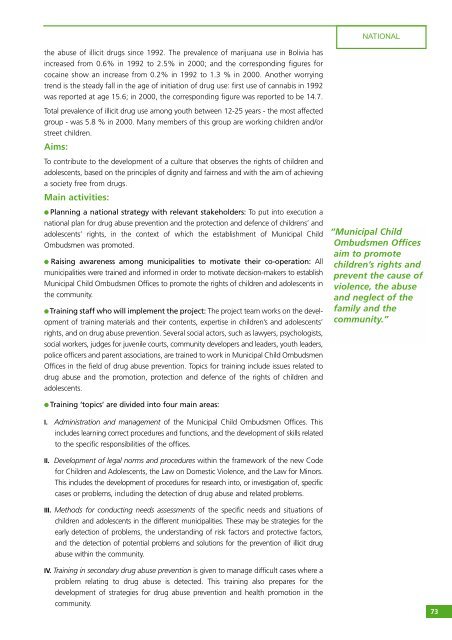PDF (Lessons learned in drug abuse prevention: a global review)
PDF (Lessons learned in drug abuse prevention: a global review)
PDF (Lessons learned in drug abuse prevention: a global review)
You also want an ePaper? Increase the reach of your titles
YUMPU automatically turns print PDFs into web optimized ePapers that Google loves.
NATIONAL<br />
the <strong>abuse</strong> of illicit <strong>drug</strong>s s<strong>in</strong>ce 1992. The prevalence of marijuana use <strong>in</strong> Bolivia has<br />
<strong>in</strong>creased from 0.6% <strong>in</strong> 1992 to 2.5% <strong>in</strong> 2000; and the correspond<strong>in</strong>g figures for<br />
coca<strong>in</strong>e show an <strong>in</strong>crease from 0.2% <strong>in</strong> 1992 to 1.3 % <strong>in</strong> 2000. Another worry<strong>in</strong>g<br />
trend is the steady fall <strong>in</strong> the age of <strong>in</strong>itiation of <strong>drug</strong> use: first use of cannabis <strong>in</strong> 1992<br />
was reported at age 15.6; <strong>in</strong> 2000, the correspond<strong>in</strong>g figure was reported to be 14.7.<br />
Total prevalence of illicit <strong>drug</strong> use among youth between 12-25 years - the most affected<br />
group - was 5.8 % <strong>in</strong> 2000. Many members of this group are work<strong>in</strong>g children and/or<br />
street children.<br />
Aims:<br />
To contribute to the development of a culture that observes the rights of children and<br />
adolescents, based on the pr<strong>in</strong>ciples of dignity and fairness and with the aim of achiev<strong>in</strong>g<br />
a society free from <strong>drug</strong>s.<br />
Ma<strong>in</strong> activities:<br />
● Plann<strong>in</strong>g a national strategy with relevant stakeholders: To put <strong>in</strong>to execution a<br />
national plan for <strong>drug</strong> <strong>abuse</strong> <strong>prevention</strong> and the protection and defence of childrens’ and<br />
adolescents’ rights, <strong>in</strong> the context of which the establishment of Municipal Child<br />
Ombudsmen was promoted.<br />
● Rais<strong>in</strong>g awareness among municipalities to motivate their co-operation: All<br />
municipalities were tra<strong>in</strong>ed and <strong>in</strong>formed <strong>in</strong> order to motivate decision-makers to establish<br />
Municipal Child Ombudsmen Offices to promote the rights of children and adolescents <strong>in</strong><br />
the community.<br />
●Tra<strong>in</strong><strong>in</strong>g staff who will implement the project: The project team works on the development<br />
of tra<strong>in</strong><strong>in</strong>g materials and their contents, expertise <strong>in</strong> children’s and adolescents’<br />
rights, and on <strong>drug</strong> <strong>abuse</strong> <strong>prevention</strong>. Several social actors, such as lawyers, psychologists,<br />
social workers, judges for juvenile courts, community developers and leaders, youth leaders,<br />
police officers and parent associations, are tra<strong>in</strong>ed to work <strong>in</strong> Municipal Child Ombudsmen<br />
Offices <strong>in</strong> the field of <strong>drug</strong> <strong>abuse</strong> <strong>prevention</strong>. Topics for tra<strong>in</strong><strong>in</strong>g <strong>in</strong>clude issues related to<br />
<strong>drug</strong> <strong>abuse</strong> and the promotion, protection and defence of the rights of children and<br />
adolescents.<br />
“Municipal Child<br />
Ombudsmen Offices<br />
aim to promote<br />
children’s rights and<br />
prevent the cause of<br />
violence, the <strong>abuse</strong><br />
and neglect of the<br />
family and the<br />
community.”<br />
● Tra<strong>in</strong><strong>in</strong>g ‘topics’ are divided <strong>in</strong>to four ma<strong>in</strong> areas:<br />
I. Adm<strong>in</strong>istration and management of the Municipal Child Ombudsmen Offices. This<br />
<strong>in</strong>cludes learn<strong>in</strong>g correct procedures and functions, and the development of skills related<br />
to the specific responsibilities of the offices.<br />
II. Development of legal norms and procedures with<strong>in</strong> the framework of the new Code<br />
for Children and Adolescents, the Law on Domestic Violence, and the Law for M<strong>in</strong>ors.<br />
This <strong>in</strong>cludes the development of procedures for research <strong>in</strong>to, or <strong>in</strong>vestigation of, specific<br />
cases or problems, <strong>in</strong>clud<strong>in</strong>g the detection of <strong>drug</strong> <strong>abuse</strong> and related problems.<br />
III. Methods for conduct<strong>in</strong>g needs assessments of the specific needs and situations of<br />
children and adolescents <strong>in</strong> the different municipalities. These may be strategies for the<br />
early detection of problems, the understand<strong>in</strong>g of risk factors and protective factors,<br />
and the detection of potential problems and solutions for the <strong>prevention</strong> of illicit <strong>drug</strong><br />
<strong>abuse</strong> with<strong>in</strong> the community.<br />
IV. Tra<strong>in</strong><strong>in</strong>g <strong>in</strong> secondary <strong>drug</strong> <strong>abuse</strong> <strong>prevention</strong> is given to manage difficult cases where a<br />
problem relat<strong>in</strong>g to <strong>drug</strong> <strong>abuse</strong> is detected. This tra<strong>in</strong><strong>in</strong>g also prepares for the<br />
development of strategies for <strong>drug</strong> <strong>abuse</strong> <strong>prevention</strong> and health promotion <strong>in</strong> the<br />
community.<br />
73
















